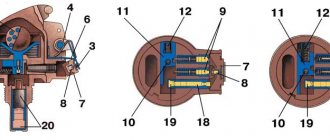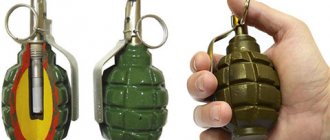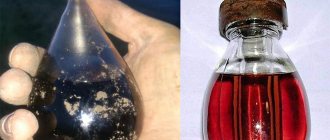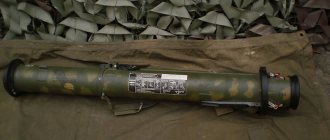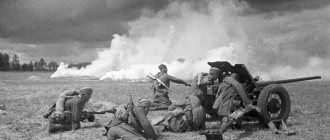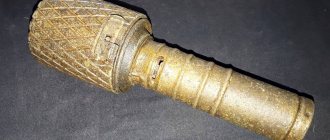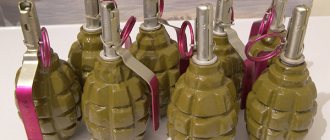Type of anti-tank grenade
| RPG-43 | |
| Type | Anti-tank grenade |
| Place of origin | Soviet Union |
| Service history | |
| In service | since April 1943 [1] |
| Used | Soviet Union and Warsaw Pact countries |
| Wars |
|
| Production history | |
| Designer | Belyakov N.P. [1] |
| Designed by | 1942–1943 [1] |
| Characteristics | |
| Weight | 1,200 kg [1] |
| Diameter | 95 mm |
| Filling | Cumulative charge of TNT |
| Filling weight | 0.610 kg [1] |
| Detonation mechanism | Inertial impact fuze |
RPG-43
(for
ruchnaya protivotankovaya Granat obraztca 1943 -
meaning "hand-held anti-tank grenade launcher") was a high-explosive anti-tank (HEAT) hand grenade used by the Soviet Union during World War II. It entered service in 1943, replacing the earlier RPG-40 and RPG-41 models. The RPG-43 used a shaped charge warhead, while the RPG-40 used a simpler high explosive warhead. The RPG-43 had a penetration of about 75 mm of rolled homogeneous armor at an angle of 90 degrees. Later during the war it was improved and became the RPG-6.[1]
History[edit]
In the early days of Operation Barbarossa, the only anti-tank infantry weapons in the USSR were anti-tank rifles, anti-tank rifles [2] and anti-tank hand grenades. They were sufficient against early German tanks such as the Panzer I and Panzer II, but as the war progressed they proved almost useless against the heavier Panthers and Tigers. As a result, the RPG-43 was developed, which was produced in large quantities until the end of the war. After the war, it was widely transferred to Soviet client states and was used in numerous Arab-Israeli conflicts. Although completely obsolete, it can still be found in many Third World countries, mainly due to its reliability and low cost. .
Heavy high explosive
Special anti-tank grenades with instantaneous impact fuses appeared already in 1941 - their development and introduction was facilitated by the experience of the Soviet-Finnish War. When a specialized design bureau GSKB-30 was created in the system of the People's Commissariat of Ammunition under the leadership of N.P. Belyakov at Plant No. 58 named after. K.E. Voroshilov, it began work on a new fragmentation grenade, anti-tank and anti-tank incendiary grenades. Anti-tank hand grenades of this period were heavy high-explosive projectiles. At first, a relatively light grenade weighing 850 g was tested, but its penetrating (more precisely, breaking through) effect was clearly insufficient - armor no more than 10 mm thick was affected. And in 1940, the RPG-40 strike action RPG, created by M. I. Puzyrev at GSKB-30, entered service with the Red Army. Anti-tank high-explosive hand grenades differed from anti-personnel fragmentation grenades not only in their greater weight, but also in their higher filling factor: they had a thin-walled body, and the mass of the explosive charge was 50–60% of the total mass of the grenade.
The RPG-40 could penetrate armor up to 20 mm thick. The handle contained an instantaneous inertial fuse with a firing mechanism and a safety pin. Before being thrown into the axial channel of the body - modeled on the RGD-33 hand-held fragmentation grenade - a detonator was inserted through a hole in the cover.
But in terms of the “armor-piercing” effect of the grenade, it soon ceased to satisfy the changed requirements of anti-tank defense - when it exploded on the surface of armor more than 20 mm thick, it only formed a dent, without causing dangerous spalls from the inside. However, in the initial period of the war, the RPG-40 remained an important anti-tank weapon in the infantry, especially since the Wehrmacht combat tank units still used light tanks Pz.II, Pz.38(t), Pz.35(t).
Orders for the production of grenades were distributed among many factories that were urgently transferred to the production of military products. This naturally gave rise to problems. The report of the first secretary of the MK and MGK of the All-Union Communist Party of Bolsheviks, A.S. Shcherbakov, dated December 6, 1941, on the production of grenades by Moscow factories said the following: “The unsatisfactory implementation of the plan for the RPG-40 is explained, on the one hand, by the evacuation of a number of enterprises manufacturing parts for this grenade (KIM and No. 191 plants), and, on the other hand, the fact that the NKB acquisition bureau was not involved in the work of the enterprises... Without grenades, and primarily anti-tank grenades, it is now impossible to fight. We are obliged to give the front, all our soldiers, as many grenades as they need. But in November the plan for grenade bodies was not fulfilled, and for grenade equipment the situation was extremely bad. The RPG-40 and RGD-33 grenade equipment is deployed with great difficulty. Only from the second half of November the production of grenades began to increase day by day.”
In 1941, M.I. Puzyrev, based on the RPG-40, created the RPG-41 with an explosive charge increased to 1400 g and armor penetration increased to 25 mm. The grenade passed field tests in April 1941. Although the RPG-41 was adopted, the reduced throwing range (up to 10–15 m for the RPG-41 and up to 20 m for the RPG-40) did not contribute to its widespread use (the mass of the grenade increased to 1800 g versus 1200 g for the RPG-40) .
In July 1941, the military council of the Northern Front gave the task of developing a hand-held anti-tank grenade for production at Leningrad enterprises. On July 10, the bureau of the Leningrad Civil Code of the All-Union Communist Party of Bolsheviks adopted a resolution on the production of 100 thousand hand anti-tank grenades within a month. Inventor A. N. Selyankin, based on the fragmentation RGD-33, with the participation of its designer M. G. Dyakonov, created a high-explosive anti-tank grenade with an explosive charge increased to 1 kg, also designated RPG-41, but also known under the designation RGD. Grenades were equipped with flaked TNT, stuffing it into the body with wooden mallets. Already in 1941, about 798 thousand of these grenades were produced (in total, Leningrad enterprises sent 3 million 150 thousand hand grenades to the front). In September 1941, in the workshops of the Artillery Research Maritime Institute in Leningrad, at the suggestion of military engineer 2nd rank Denisov, they produced a batch of high-explosive anti-tank grenades... with a glass body.
With the increase in supplies of heavy high-explosive grenades in 1942, the scale of their use also increased. Grenades were also intended to “destroy strong closures”; they were used against enemy fortified points, when fighting in trenches and in urban battles. It is no coincidence that the famous statue of E. V. Vuchetich “Fought to the Death” depicts a warrior with a PPSh and a heavy high-explosive grenade in his hands. Among the soldiers, anti-tank grenades were nicknamed Tanyusha. Due to their massiveness, they were sometimes used in hand-to-hand combat - in a desperate situation, fighters simply “jammed” the enemy with them.
Anti-tank grenades were widely used by partisans and sabotage groups to undermine equipment, organize sabotage and attacks on convoys. Here are the lines from the report of the command of the partisan detachment of the Ostashevsky district to the NKVD Directorate for Moscow and the Moscow region, December 1941: “The detachment was armed with: rifles - 35... revolvers - 9... pistols - 4, mines - 50, machine guns - 2 , PT grenade - 40, RGD grenade - 200, mixture No. 1 - 100... In total, the detachment destroyed: 2 tanks, 9 armored vehicles, 14 trucks, 2 cars, 4 motorcycles, blown up a bridge - 1, burned the base with fuel - 1..."
The certificate on the work of the special school of the NKVD Directorate for Moscow and the Moscow region for the period from September 1941 to September 1942 stated: “In light of the changed tasks performed by partisan sabotage and extermination detachments behind enemy lines, the report card of their weapons has also changed. The number of PPSh and PPD machine guns/pistols in the squads' arsenal has been increased (from 3 to 8 pieces per squad). The detachments were supplied with RGD-33, F-1 grenades, anti-tank grenades, Serdyukov rifle grenades and various mines.”
The same was stated in the report of the head of the NKVD of Moscow and the Moscow region on the activities of destroyer battalions and partisan detachments from June 25, 1941 to January 25, 1942: “In accordance with the requirements of combat operations behind enemy lines, all students ... studied all types of mines and various weapons ( Serdyukov grenades, German machine guns and machine guns, PPD and PPSh submachine guns, anti-tank grenades, etc.).”
High-explosive anti-tank grenades with an increased charge of factory and semi-handicraft production were also used in the defense of Odessa and Sevastopol; various versions of the grenades were created in partisan workshops.
Description[edit]
The RPG-43 externally resembled a large hand grenade with a 95 mm cumulative warhead at the end. It weighed 1.247 kg, of which 612 g was high-explosive fragmentation. When thrown, a cylindrical metal cone emerged from the back of the grenade, which was held in place by fabric strips to stabilize the flight and increase the likelihood of hitting at a 90-degree angle. Its range was limited by how far the user could throw it, and was clearly shorter than the modern American Bazooka missile base and the German Panzerfaust without recoil, so that the user would have to get closer to avoid being noticed again. However, it was much smaller than a rocket weapon and did not produce sound, smoke or light when launched, and therefore did not give away the position of the thrower. Despite its limitations, it was cheap and quick to produce, allowing it to become the primary anti-tank weapon for Soviet infantry in World War II.
The task is not for the weak
Further experience of “small” and civil wars (including in Russia and Spain) confirmed that hand grenades play an important role in anti-tank defense. In the Soviet “Manual on Shooting” of 1935, for example, a description was given of the manufacture of bundles of hand grenades mod. 1914/30 and arr. 1933: grenades were tied with twine or wire in groups of three or five so that the handle of the central one looked in one direction, and the others in the opposite direction. Defensive grenades of the F-1 or Milsa type were tied tightly in a bag. There are examples of Soviet soldiers using bunches of hand grenades against Japanese tanks at Khalkhin Gol in 1939.
Bundles of grenades seemed a convenient solution, especially since they could be used to destroy fortified firing points and to undermine barriers - it was envisaged, for example, to tie ropes with weights to them to “hang” on a wire fence.
A bunch of five hand-held fragmentation weapons RGD-33 weighed about 2.5 kg; not everyone could throw such a load 15 m, and even from a prone position or from a kneeling position. High-explosive grenades or bundles could cause real damage to a tank only when they hit the stern (on the roof of the engine compartment) or under the tracks and along the chassis of the tank, when they played the role of a kind of “quickly laid mine.” Therefore, they had to be thrown from behind or on the side of the tank, so the actions of tank destroyers with grenades in open areas often turned out to be suicidal. A bunch of grenades made it possible to stop a vehicle, but did not always destroy it - a stalled tank had to be taken under fire from other, more effective means.
Senior political instructor Zhelezovsky described an episode of the actions of the 12th Infantry Regiment of the 53rd Infantry Division near Maloyaroslavets in October 1941: “On the morning of the same day (October 17 - S.F.) two enemy tanks appeared, and in the evening 17 more tanks appeared, who passed through Cherkasovo to Maloyaroslavets. We had nothing with which to fight the tanks... We detained the infantry and pushed them back to Cherkasovo. The tanks advanced to Maloyaroslavets and after a while began to return. By this time, I had found bottles of COP in the forest - 40 of them. Organized a group of demolitions. He threw a bunch of shells under the first tank. The tank was damaged. Subsequently, bottles were thrown into the tanks, but unsuccessfully. The tanks left and towed away the damaged tank.”
Fragmentation hand grenades had a remote fuse, and their use required not only a well-aimed throw, but also good calculation - otherwise the grenades would explode before the tank ran into them, or after driving over them. If they hit the roof, the grenades could simply bounce off the armor before exploding.
However, bundles of hand grenades - a means that was easily and quickly “prepared” by the troops themselves from available fragmentation grenades - continued to be used throughout the Great Patriotic War. To be fair, we note that the enemy also widely used such combinations in his anti-tank defense system.
Tactics [edit]
Overall, the RPG-43 was an inconvenient and difficult weapon to use. To use it, the user had to be within throwing distance of an enemy tank, which was often dangerous. Despite having a powerful warhead, it required a skilled user to get the most out of it as, like all HEAT weapons, it was only effective at an impact angle close to 90 degrees. It also had to hit hard enough to detonate the fuse, otherwise it would bounce harmlessly off the tank.
Radical fracture
Given their large mass, the effectiveness of high-explosive anti-tank grenades soon ceased to correspond to their main purpose. But in return, the infantry received cumulative grenades.
Studies of cumulative (from the late Latin cumulatio - accumulation, con) were carried out in the second half of the 19th century. In Russia, the directed action of an explosion in the presence of a notch in the explosive charge was discovered by military engineer M. M. Boreskov in 1865, in Germany - M. Fester in 1883 -m. However, in the latter, this effect is better known as the Neumann effect (E. Neumann published his works in 1914, and in the English-speaking world - as the Munro effect, named after the American C. Munro (or Monroe), who published his research in 1888 year.
For a long time, no attention was paid to this effect as a way to obtain a new type of armor-piercing projectile. He was more interested in civil engineers. Thus, in the USSR, a study of the practical application of shaped charges in construction was carried out in the 20s by M. Ya. Sukharevsky. By the beginning of World War II, samples of engineering shaped charges were developed to destroy concrete and armored caps. Other countries were also actively working on shaped charges - for example, there was already information about German shaped charge shells, which we then received the not entirely correct name of armor-burning. In September 1941, on the initiative of the Scientific and Technical Council for the Coordination and Strengthening of Scientific Research in the Field of Chemistry under the State Defense Committee (GKO), systematic work began on using the effect of cumulation of explosion energy to create anti-tank ammunition. Already in October 1941, tests of shaped charges were carried out at the Research Institute-6 of the People's Commissariat of Ammunition.
Links[edit]
- ^ abcdefg Weapon of Victory / coll. ed., rep. ed. V. N. Novikov. 2nd ed., Trans. and additional M., “Mechanical Engineering”, 1987. p. 427 (in Russian).
- for example, 45-mm anti-tank gun M1937 (53-K)
- Small Arms Review (1998). Politics from the Barrel of a Gun: (PDF). Cambridge University Press. paragraph 40.
- RPG-43 anti-tank hand grenade // North Korea Country Reference MCIA-2630-NK-016-97. US Department of Defense, May 1997 p. A-102
The newest RPG
After the appearance of the reusable RPG-7 in service with the Soviet and Russian armies, no worthy replacement for the legendary “seven” appeared. The most modern domestic development of this class today is the RPG-32
. At the same time, the grenade launcher itself has become an exclusively export product and is not used by Russian security forces.
Turnkey export project
The development of a new generation of hand-held anti-tank grenade launchers (RPGs) first became known in 2006 at the SOFEX exhibition. A year earlier, the Basalt enterprise, the leading Russian developer of anti-tank grenade launchers, began work on the RPG-32, commissioned by Jordan and financed by it. The joint project included not only the creation of a grenade launcher complex, but also the construction of a joint assembly plant in Jordan for the production of finished products. The project was named "Hashim" in honor of the ruling Jordanian royal dynasty of the Hashemites.
RPG-32 is a reusable grenade launcher, which differs from the classic and familiar domestic RPGs of the same class. The triggering device is a compact unit on which optical instruments and a firing mechanism are mounted. It is also accompanied by special cartridges with ammunition. This option allows the use of rocket-propelled grenades of various calibers - for example 72.5 mm or 105 mm. This allows you to select the required grenade launcher ammunition depending on the task at hand or the current situation.
A Jordanian soldier fires a 105-mm PG-32V round from an RPG-32
Image source: rostec.ru
The RPG-32 kit can include two types of shots: anti-tank cumulative PG-32V and thermobaric TBG-32V. A container with a thermobaric grenade is additionally marked with one or two orange stripes. The 105-mm PG-32V round is identical in design and characteristics to the RPG-27 or PG-7VR, and the TBG-32V of the same caliber is an analogue of the RShG-1 or TBG-7V. In a smaller caliber, such shots can replace the RPG-26 and RShG-2. Essentially, the RPG-32 modular grenade launcher system combines four types of standard close-combat ammunition with the ability to select any of them.
For aiming, the grenade launcher is equipped with a standard 1P81 day sight, which has the ability to make adjustments depending on the type of shot and the ambient temperature. During transportation and stowage, the 1P81 sight can be stored inside the 6G40 launcher. The launcher itself can withstand about 200 shots from any type of grenade.
RPG-32 grenade launcher complete with 72 mm TBG-32V round
Image source: otvaga2004.ru
As already mentioned, a joint Russian-Jordanian venture was created to implement the ambitious project, and a large-scale advertising campaign began in the media. In the late 2000s and early 2010s, news about the RPG-32 Hashim project appeared with enviable regularity, experimental products were demonstrated at various international exhibitions, but the completion of the high-profile project was constantly postponed to a later date.
Anti-tank "Crossbow"
Over time, references to the joint Russian-Jordanian company JRESCO disappeared from advertising. The project was renamed “Nashshab” (translated from Arabic as “crossbow” or “destroying”), and today the manufacturer of the RPG-32 is Jadara Equipment & Defense Systems, specially created for these purposes. Gradually, a new grenade launcher began to appear in the military chronicles of the troubled Middle East region - the use of the RPG-32 was noted not only in Jordan, but also in Libya, Egypt, Iraq, Yemen, and the UAE.
Assembly of RPG-32 at a plant in Jordan
Image source: rostec.ru
The completion of the full range of works of the joint Russian-Jordanian project was planned for two years, but then was postponed to 2009, which also did not happen. Just at this time, a corruption scandal broke out at the Basalt enterprise, as a result of which the director and general designer received suspended prison sentences. Against this background, intellectual property problems arose in relation to the RPG-32 grenade launcher. The production of system components was completely transferred to the Kirov JSC Novo-Vyatka.
In this regard, the deployment of mass production in Jordan was delayed for several years. During this period, the grenade launcher was slightly modified and modernized. The 72.5 mm caliber variant disappeared from advertising brochures. The grand opening of the production of Nashshab grenade launchers took place on May 30, 2013. At the same time, we are not talking about the full production cycle, but only about the final assembly of grenade launchers from Russian components.
PUI-32 set: UPI-32 launcher and IRG-32V round
Image source: tass.ru
For training shooting, Basalt specialists developed a training version of the PUI-32 grenade launcher, including a UPI-32 launcher and an IRG-32V shot simulator. This option makes it possible to conduct training simulating real combat firing with 42-mm IRG-32 grenades at a lower cost compared to classic inert ammunition.
Patents for ammunition components belong to Basalt, and one of the patents for a grenade launcher system is issued to OJSC Tulatochmash. Probably, it is the specialists from Tulatochmash who are involved in the development of the starting device. This is somewhat unusual, since specialized enterprises for these purposes have always had another Tula enterprise - the Central Design Research Bureau of Sports and Hunting Weapons (TsKIBSOO). At the same time, it is Tulatochmash that for many years has been engaged in the serial production of launching devices for RPGs developed at TsKIBSOO.
Belarusian trace
There is also a Belarusian trace in the history of the Russian-Jordanian grenade launcher. The standard daytime optical sight 1P81 (PGK-1) was developed and produced by the Belarusian holding BelOMO. In addition to the PGK-1 (GS-1DN) kit, Belarusian specialists added the GPD-1 (GS-2R) sight with a built-in ballistic computer and laser rangefinder. These sights can be equipped with NV/A-1 or NV/A-2 night attachments, as well as a TC/A-1 thermal imaging device.
Set of RPG-32 “Nashshab” grenade launcher system, 2013
Image source: jadara.jo
As the Jordanian side notes, the Belarusian enterprise, which won an open tender for the development of optics, was able to provide high-quality products at a reasonable price, while promptly making the necessary changes as the project was modernized. Also, by the efforts of Belarusian engineers, the complete set of the Nashshab grenade launcher included the JR-SIM-32 electronic simulator, which allows grenade launchers to be trained in firing from RPG-7, RPG-29 and RPG-32. It provides a three-dimensional visual interactive picture of the area and simulates various conditions, visual and sound effects.
A further development of the grenade launcher was the remote-controlled QUAD complex, which is an installation of quad RPG-32 grenade launchers. In the QUAD-1 version it can be mounted on a tripod stand, and in the QUAD-2 version it can be mounted on the roof of a lightly armored vehicle. The development of such a complex was also carried out by specialists from the scientific and technical holding BelOMO. To control the four grenade launchers, the Izumrud optical-electronic system with a GS-TV rangefinder sight is used.
Installation of QUAD-2 at the Milex-2017 exhibition. Photo by the author
Image source: warspot.ru
RPG-34 or “Mixture”
It is worth noting that all elements of the export project received GRAU indices: grenade launcher - 6G40, transport and launch container - 6G41, shots - 7P65 and 7P66, optical sight - 1P81. All this indicates interest in the product on the part of the Russian Ministry of Defense and a direct attitude towards it. At the end of the 2000s, the press repeatedly wrote about the interest in the grenade launcher system on the part of representatives of official army structures. The name of the domestic R&D “Barkaz” for the development of the RPG-32 in the interests of the GRAU has appeared on the Internet. However, there is still no information about the adoption of the RPG-32 into service by the Russian army.
Some experts associate this state of affairs with the personality of the former director of Basalt V.V. Korenkov, who headed the development of the RPG-32 and was fired from this post in the midst of work on the grenade launcher. It was after his departure that the process of finalizing the complex slowed down greatly, and over time the grenade launcher finally left the Russian domestic market. Others claim that he “pulled the blanket” to himself in a new place, leading the development of a more promising grenade launcher. However, in addition to the 61-mm small-sized RPG-34 project, developed at MSTU. N.E. Bauman under his leadership, there is no other information about this direction.
Demonstration of the development of Russian promising grenade launchers
Image source: forum.guns.ru
It is more likely that the GRAU immediately relied on a more promising grenade launcher system, which is being developed within the framework of the Mixture design and development project as part of the third generation Sotnik (Ratnik-3) equipment. There is very little data about a new development that leaks into the public space and periodically changes over time. Recently it has been reported that the complex will include anti-tank and thermobaric ammunition of 72.5 mm caliber - this was the caliber of the RPG-22 and the still produced RPG-26. Probably, the latter should be replaced by a new generation of grenade launcher.
The promising 6S20 complex will also include a launcher, which is a reusable element with a mount for optical instruments. It will be accompanied by containers with finally equipped grenades. This concept largely replicates the RPG-32 device. In addition to using the modular design of the product, the ammunition itself, as well as the sighting system, will be modernized. It is planned to complete testing of the new RPG by the end of 2022, and to launch mass production by 2023 at the Nizhny Tagil chemical plant.
Technical characteristics of the complex
| RPG-32 | PG-32V | TBG-32V | PGK-1 | |
| Index | 6G40 | 7P65 | 7P66 | 1P81 |
| Caliber (diameter), mm | 105 | 72 / 105 | 105 | 122,5 |
| Length, mm | 375* / 1200 | 900 / 1000 | 1000 | 195 |
| Weight, kg | 3* / 11,5 | 3 / 7,5 | 7,5 | 1,5 |
| Initial speed of the grenade, m/s | 140 | 140 | 140 | – |
| Effective firing range, m | 500-700 | 500 | 700 | – |
| Armor penetration, mm including behind dynamic protection, mm reinforced concrete wall, mm brick wall, mm | – | 500 / 750 440 / 650 1500 2000 | – | – |
* - characteristics of the launcher with an optical sight 1P81
Literature:
- V.G. Boychenko, V.G. Smelikov. Mastyazhart - GSKB-47 - FSUE "GNPP "Basalt". — M.: “Association “LSOP”, 2011
- E.N. Nikulin, V.F. Russkov, I.A. Semenov. Melee weapons. Hand grenade launchers. - St. Petersburg: BSTU "Voenmech", 2008
- P. Sidorov, V. Tokarev. Absorbed the best. Magazine "Weapons", No. 5, 2011
Ruslan Guk

